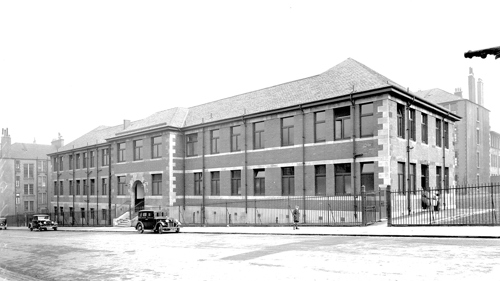Green Ladies and Child Welfare - Times Past

In partnership with the Glasgow Times, our archivists are exploring Glasgow's fascinating history. This week, Barbara McLean writes about the Green Ladies and child welfare.
“Quick, the Green Lady’s coming!” Once upon a time, this phrase would have echoed throughout many of Glasgow’s homes, causing a flurry of tidying and families getting ready for her visit.
The Green Ladies were a popular nickname for Glasgow Corporation’s municipal midwives and health visitors, so-called because of their distinctive bottle-green uniform. It was the responsibility of each local authority to provide a uniform of its own design and colour to the nurses in their employ, including midwives. In Glasgow, the dear green place, the colour choice was obvious. The women wore green gabardine raincoats and brimmed hats in summer and green wool coats and hats in winter.
The Corporation’s health visitors undertook child welfare visits to family homes. The Green Ladies offered advice on feeding, hygienic food preparation and domestic cleanliness. They were there to offer support and help rather than judgement but many families still feared their visit. A neighbour’s rallying cry that she was on her way gave them time to prepare.
The Green Ladies owe their origins to earlier city initiatives to improve maternal and child health in the city. The Glasgow Infant Milk Depot opened in Osborne Street in 1904. It provided milk, either cheaply or for free, to families with newborn and growing infants.
In addition, after The Notification of Births Act 1907, every birth was required to be notified to the Medical Officer of Health within thirty-six hours. This provided the local authority contact with mothers and infants who weren’t already medically attended. It also provided the data required for setting up the health visitor scheme. After 1918, further strides in improving healthcare for mothers and infants were made. New Maternity and Child Welfare Centres opened in several districts. The first was in Bridgeton in 1925 followed by others in Maryhill, Springburn, Govan, Shettleston and Anderston. Pictured is the newly-built Child Welfare Clinic in Glenbarr Street, Royston (March 1936).
Not all Green Ladies were health visitors. Some were domiciliary midwives for Glasgow Corporation. When the city’s midwifery service was originally set up, it was decided to adopt the same uniform worn by the health visitors. The municipal midwives then joined the ranks of the Green Ladies.
During the twentieth century, these municipal midwives assisted expectant mothers to give birth at home and provided both pre-natal and post-natal care for the women on their books. When on call, the midwives could be summoned to attend a labouring mother at any hour of the day or night. They usually travelled by public transport or Corporation car.
There are several references to the midwives in our Glasgow Corporation Department of Health archives. According to a 1945 annual report, the city was split into divisions (Eastern, Northern, Central, South-Eastern and South-Western). The report lists the names of each midwife and the division they were assigned to cover.
As the twentieth century wore on, national services replaced local ones and the Green Ladies, once such a visible part of the city, were no more.
